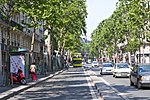Gnomon of Saint-Sulpice
Astronomical instrumentsBuildings and structures in ParisBuildings and structures in the 6th arrondissement of Paris

The Gnomon of Saint-Sulpice is an astronomical measurement device located in the Church of Saint-Sulpice (Église Saint-Sulpice) in Paris, France. It is a gnomon, a device designed to cast a shadow on the ground in order to determine the position of the sun in the sky. In early modern times, other gnomons were also built in several Italian and French churches in order to better calculate astronomical events. Those churches are Santa Maria del Fiore in Florence, San Petronio in Bologna, and the Church of the Certosa in Rome. These gnomons ultimately fell into disuse with the advent of powerful telescopes.
Excerpt from the Wikipedia article Gnomon of Saint-Sulpice (License: CC BY-SA 3.0, Authors, Images).Gnomon of Saint-Sulpice
Rue Palatine, Paris Quartier de l'Odéon (Paris)
Geographical coordinates (GPS) Address Website Nearby Places Show on map
Geographical coordinates (GPS)
| Latitude | Longitude |
|---|---|
| N 48.850972222222 ° | E 2.3349166666667 ° |
Address
Église Saint-Sulpice
Rue Palatine 2
75006 Paris, Quartier de l'Odéon (Paris)
Ile-de-France, France
Open on Google Maps











